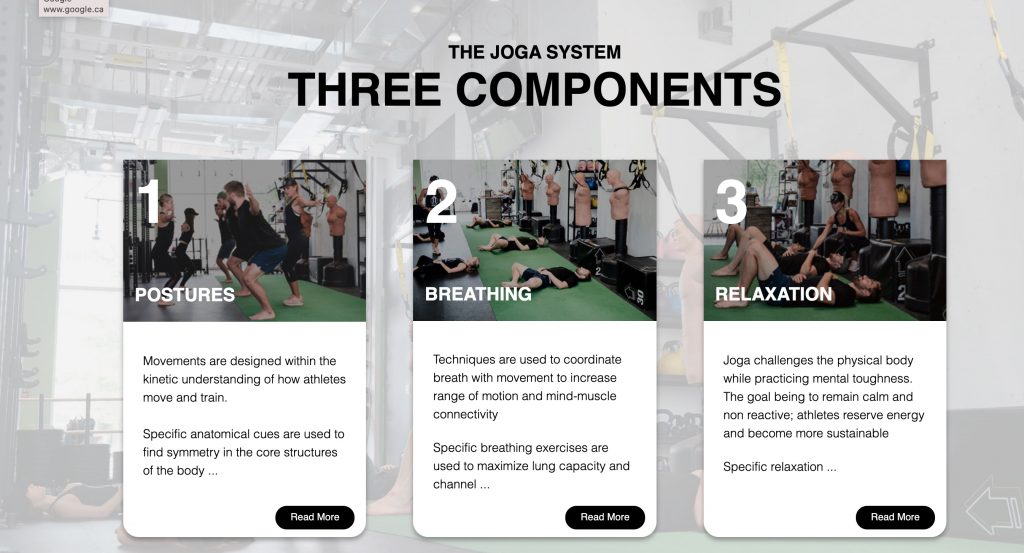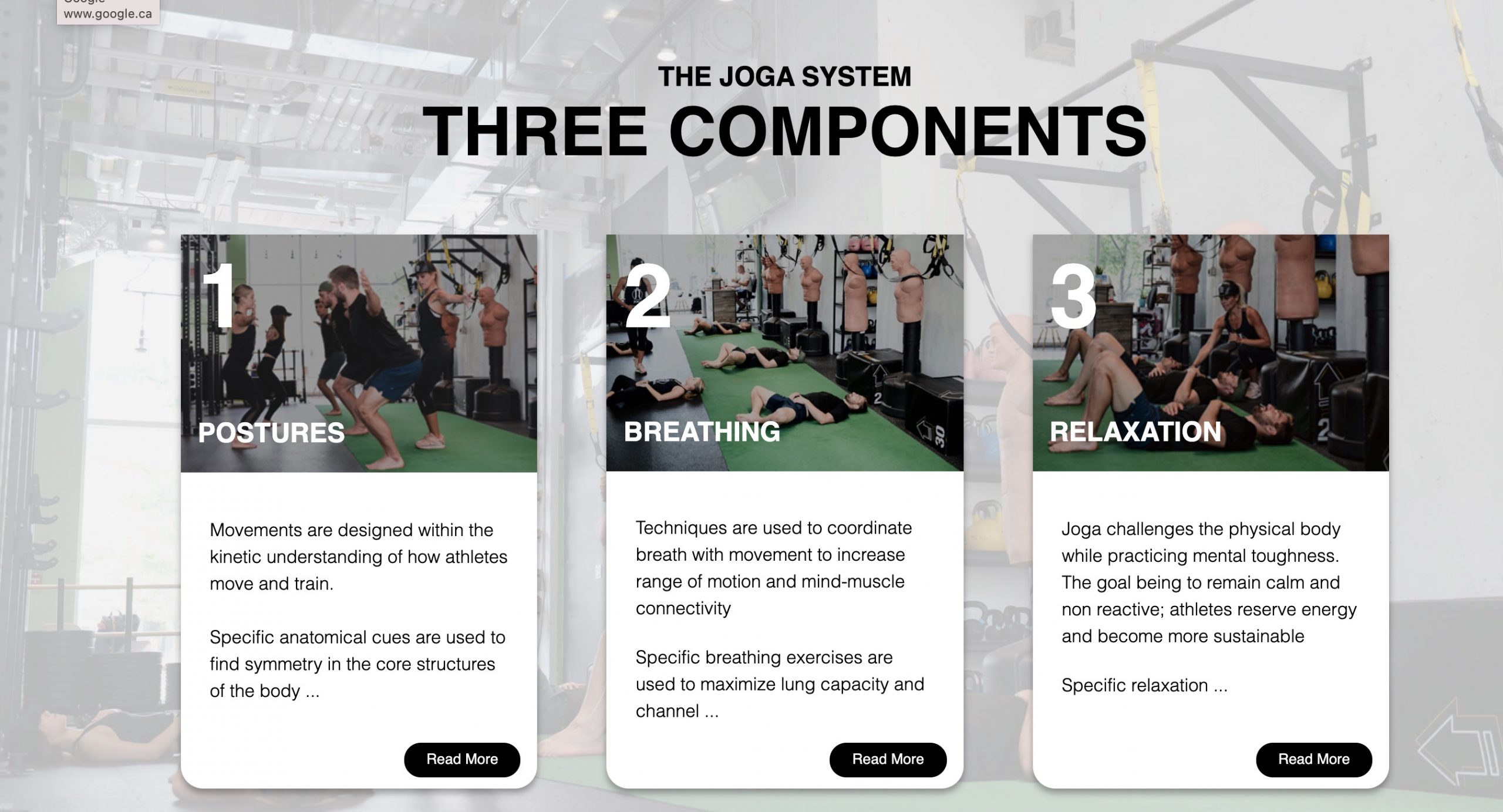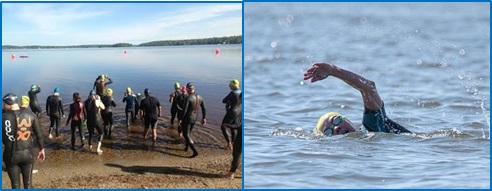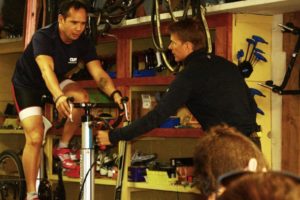It looks like yoga, it sounds like yoga – but JOGA is its own game. It is a movement system developed to mimic the biomechanics and neuromuscular demand of sport. That sounds like a bunch of trainer jargon, right? So, what does it mean for you the athlete? JOGA really is designed for you, the athletic body — the tight workhorse that that is pushed to peak performance and adapts to repetitive movement usually developing asymmetry to carry it through its athletic demands. Where yoga can sometimes feel intimidating to the athlete who feels they need to bend like a pretzel or become zen like Buddha; JOGA welcomes our asymmetries, inflexibility, and overactive minds. JOGA meets the athlete where they are to develop mobilization, stability, efficiency, and calm.

In sport we operate through both dynamic and static movement, we have something stable (tension) and something mobile (firing) – think of running, our upper bodies and trunks are primarily stable while simultaneously our lower bodies are mobile. In sport to maximize how our bodies operate in this dualized environment, we need increased range of motion, a strong foundation (think transverse abdominals, lumbar stability, etc.), and joint mobility/stability. Yoga isn’t bad, but the movements and the neuromuscular patterns developed are opposite to how we move in sport. The way we move in JOGA is how we move in sport – static and dynamic. JOGA uses the tension we have in our bodies (in the same way we use our tension in sport) to find mobilization, which for the athlete means increased range of motion — longer strides, greater extension, increased reach, higher jumps etc.
Looking for a practical example to understand how adding JOGA to your regime change the way you show up and play? Let’s start with something really basic, the breath. Running as we all know is taxing on our cardiovascular system – sure, it gives us a rush and gets all sorts of endorphins flowing; but at the same time its demanding on the body and the mind (= stress). How many times have you gone for a run and had to hit that “breakthrough” kilometre (or mile for our friends in the US) before it actually started to feel great and your mind shifted from “I have to do this because it’s part of my training” to “I got this and I want to do this!”? You might start your run feeling short of breath, constricted through the chest, and with a mind that’s feeding your body a whole bunch of signals that are saying, “what the heck is going on here?!” Let’s call it performance anxiety. This is where JOGA can help in a seemingly simple way. The foundation of JOGA is our breath – it is used to prime our bodies for our JOGA workout by helping us balance our nervous systems, while at the same time using movement increase our breath volume.
What are our nervous systems and why do they matter for your performance as a triathlete? Well put simply, our parasympathetic nervous system is our system that promotes calm while the sympathetic does just the opposite, it hypes us up and gets us ready for game time. Some people think of the sympathetic system as our stress-managing system. As an athlete we need to strike a balance of both to maximize our performance – we want our body to be ready for stress (our body’s performance and output) but our mind to maintain its calm so we can show up without our stress overwhelming us or our bodies. JOGA training starts by activating these systems the same way they activate when you hit the pavement to start your run – only usually then its your sympathetic that takes the reigns (that performance anxiety you need to breakthrough before your run feels good). How does JOGA do this? First, through belly and chest breaths in warm-up organized in particular way that emphasizes nervous system balance. Second, by mindfully coordinating breath and movement throughout the program. And lastly, through carefully integrated recovery breaths that help with recuperation at specific times when our body is operating at the highest levels of tension (i.e. stress) during the program. JOGA helps us dial back our stress response so that the parasympathetic system can do its thing too and we can think and breathe through our performance. If we can train our bodies to do this in JOGA over and over again, eventually it translates into our athletic performance too (running, swimming, biking, etc.).
And what about breath volume? Can you really increase your lung capacity? Absolutely! The lungs are an organ, yes – but through training the surrounding muscle tissue we can actually enhance how this vital organ functions by giving it more space to breath – literally! By using movement and breath to stretch our intercostal muscles (the muscles between our ribs) and diaphragmatic tissue, JOGA maximizes our lung capacity and thus breath volume. Greater volume = greater output. To wrap up, through learning to control our breath and enhancing its efficiency through carefully crafted movements, we can “channel oxygen into blood flow more efficiently while simultaneously releasing carbon dioxide and monoxide from the muscle fibers” (JOGA, 2018). Huh, come again? For you the triathlete that means enhanced performance, a calmer mindset while performing, greater endurance, injury prevention, and better recovery.
As a lifelong athlete, I never quite felt comfortable in yoga classes. My body and my mind just couldn’t adapt. Sure, I got a stretch but at what cost? I usually ended up feeling like I pulled something as opposed to feeling “more flexible” and I definitely couldn’t get my mind to relax because I always felt like I was doing it wrong – and you know, as athletes we don’t like to not be good at things. JOGA stepped in to offer me something that worked with my body instead of against it – and something that coached me through the movements in a way that made my body feel stronger, more capable, and proud to be “tight” rather than “bendy.” This article highlights only one aspect how JOGA can help you as a triathlete – believe me there are countless more benefits we didn’t even touch on (for example, how JOGA keeps structural body safe, minimizes soft tissue injuries, develops range of motion, and amps up recovery – just to name a few). In the end, I’m not here to tell you yoga is bad – there are many benefits to it; but if you want something to not only support your sport performance but actually boost it; I encourage you to give JOGA a try. It’s made for you, the athlete.
- Written by Ashley Aldridge who is a JOGA Coach, TRX Coach, and Personal Trainer. She works with athletes and non-athletes alike; in individual and small group dynamics — in person and virtually. She is a lifelong athlete and mover — though competitive swimming was her favourite. She has a variety of certifications including but not limited to Canfit Pro PT, JOGA Level 1, 5 different TRX certifications, DTS Running Fundamentals, and DTS Olympic Lifting 1&2.f



